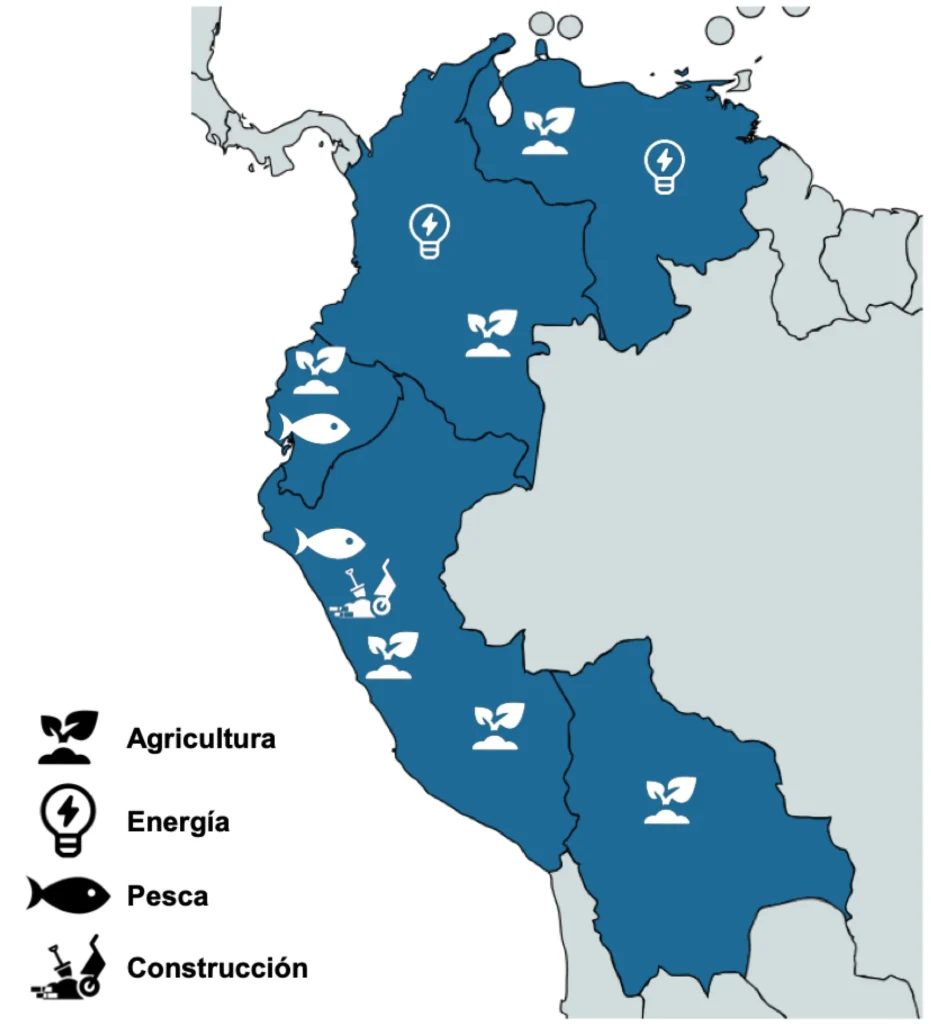September 2, 2024
Economic Repercussions of Climate Change and the El Niño Phenomenon in the Andean Region
By: Leandro Andrian, Cristhian Larrahondo, Miguel Alzamora, Augusto Chávez Baquero, Emily Díaz Rivera, Daniel Cárdenas, Luis Serrudo
Tags:
This article was initially published on the Inter-American Development Bank’s blog – Ideas que Cuentan, on July 17, 2024.
Climate change has advanced significantly, with its main effects becoming increasingly evident and frequent, such as the notable increase in temperatures and alterations in rainfall patterns. One of these effects is the El Niño phenomenon (ENSO), an anomalous warming of the surface waters of the central and eastern Pacific that, in turn, modifies the climatic conditions of the coastal areas of South America’s Pacific.
The relationship between climate change and the El Niño phenomenon in the Andean countries (Bolivia, Colombia, Ecuador, Peru, and Venezuela) can be seen in extreme weather variations. While torrential rains and floods wreak havoc on the coasts of Peru and Ecuador, severe droughts in the Andes mountains drastically reduce water availability. There have been three periods of particular exposure and impact: (1982-1983), (1997-1998), and (2016-2017), categorized, respectively, as episodes of extraordinary, strong, and moderate magnitude. And each of the three periods has had considerable socioeconomic repercussions.
A recent IDB publication: “Efectos del fenómeno “El Niño” en la región Andina: una aproximación empírica” (Effects of the “El Niño” Phenomenon in the Andean Region: An Empirical Approach), published in Spanish, thoroughly analyzes this cyclical phenomenon, exploring how and to what extent ENSO affects the economies of the Andean region. This publication focuses on variations in economic activity and price levels (inflation), two of the main macroeconomic indicators that reflect the well-being conditions of regional economies. Furthermore, it proposes measures to mitigate the effects of FEN.
Figure 1. Oceanic Niño Index (ONI)”
Source: National Oceanic and Atmospheric Administration (NOAA).

Note: Measures deviations from the average sea surface temperature in the central and eastern equatorial Pacific region. The study uses the ONI measured in a specific Pacific zone according to the country of interest. While for Peru it is Region 1+2, for the rest of the countries it is the Central Region 3.4.
El Niño: A Cyclical Weather Phenomenon
These effects vary in each Andean country, with different meteorological phenomena and different intensities. And they have different impacts on economic sectors. For example, in Bolivia, Ecuador, and Peru, ENSO has caused excessive rainfall, with significant effects on extractive activities such as fishing and agriculture. Meanwhile, in Colombia and Venezuela, it has generated a decrease in rainfall, affecting the agricultural sector and electricity generation, with consequent increases in energy tariffs and inflationary pressures.
Figure 2. Economic Sectors Most Affected by El Niño
Source: Moody’s Investors Service.

The study analyzes these economic reactions to ENSO. It examines not only inflation but also economic growth in the face of different magnitudes of ENSO, compared to a baseline scenario without the presence of the phenomenon. It also adopts a historical perspective, analyzing what the economic impact of ENSO might have been in the recent event of 2023 and, by extension, in future events of similar or greater magnitude, using previous events as a reference.
The deviations are calculated in percentage points with respect to a scenario without the presence of the El Niño phenomenon. The main results reveal that ENSO in the Andean region could have reduced economic growth by between 0.2 and 0.5 percentage points in the months of impact in 2023, and between 1.3 and 4.4 in the months of 2024, with Peru and Ecuador being the most susceptible to these impacts. A possible increase in inflation in Colombia and Peru of between 0.6 and 1.1 percentage points in 2023, and between 1.0 and 3.3 in 2024, was also 1 observed.
Figure 3. Economic Impact of the El Niño Phenomenon
Source: Author’s own elaboration.

Note: The effect represents the difference of each ENSO scenario with respect to a baseline scenario in which the phenomenon is assumed not to occur.
Lessons Learned from the Effects of the El Niño Phenomenon
These results suggest that, given the heterogeneous effects of ENSO in the Andean region, it is necessary to implement mitigation and adaptation strategies to counteract these effects at the economic and social levels. These strategies could include the reconstruction of infrastructure, the provision of subsidies to affected sectors, and conditional cash transfers to cushion the transitory effects of higher price levels on the most vulnerable people in the region. In this regard, having flexible public policymakers and adaptable economies will be crucial in efforts to counteract the negative effects of extreme weather events related to ENSO and strengthen resilience as the adversities of climate change worsen.




